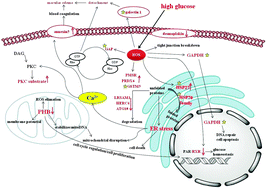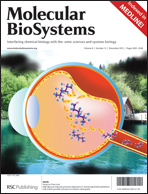High glucose-induced proteome alterations in retinal pigmented epithelium cells and its possible relevance to diabetic retinopathy†
Abstract
Diabetic retinopathy can cause poor vision and blindness. Previous research has shown that high blood glucose weakens retinal capillaries and induces glycoxidation. However, the detailed molecular mechanisms underlying the effects of high blood glucose on development of diabetic retinopathy have yet to be elucidated. In this study, we cultured a retinal pigmented epithelium cell line (ARPE-19) in mannitol-balanced 5.5 mM, 25 mM, and 100 mM D-glucose media, and evaluated protein expression and redox-regulation. We identified 56 proteins that showed significant changes in protein expression, and 33 proteins showing significant changes in thiol reactivity, in response to high glucose concentration. Several proteins that are involved in signal transduction, gene regulation, and transport showed significant changes in expression, whereas proteins involved in metabolism, transport, and cell survival displayed changes in thiol reactivity. Further analyses of clinical plasma specimens confirmed that the proteins lamin B2, PUMA, WTAP, ASGR1, and prohibitin 2 showed type 2 diabetic retinopathy-dependent alterations. In summary, in this study, we used a comprehensive retinal cell-based proteomic approach for the identification of changes in protein expression and redox-associated retinal markers induced by high glucose concentration. Some of the identified proteins have been validated with clinical samples and provide potential targets for the prognosis and diagnosis of diabetic retinopathy.


 Please wait while we load your content...
Please wait while we load your content...